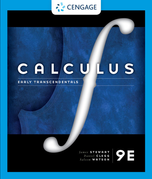?In a beehive, each cell is a regular hexagonal prism, open at one end; the other end is
Chapter 4, Problem 53(choose chapter or problem)
In a beehive, each cell is a regular hexagonal prism, open at one end; the other end is capped by three congruent rhombi forming a trihedral angle at the apex, as in the figure. Let 𝛳 be the angle at which each rhombus meets the altitude, 𝑠 the side length of the hexagon, and ℎ the length of the longer base of the trapezoids on the sides of the cell. It can be shown that if 𝑠 and ℎ are held fixed, then the volume of the cell is constant (independent of 𝛳), and for a given value of 𝛳 the surface area 𝑆 of the cell is
It is believed that bees form their cells in such a way as to minimize surface area, thus using the least amount of wax in cell construction.
(a) Calculate 𝑑𝑆/𝑑𝛳.
(b) What angle 𝛳 should the bees prefer?
(c) Determine the minimum surface area of the cell in terms of 𝑠 and ℎ.
Note: Actual measurements of the angle 𝛳 in beehives have been made, and the measures of these angles seldom differ from the calculated value by more than 28.
Unfortunately, we don't have that question answered yet. But you can get it answered in just 5 hours by Logging in or Becoming a subscriber.
Becoming a subscriber
Or look for another answer
